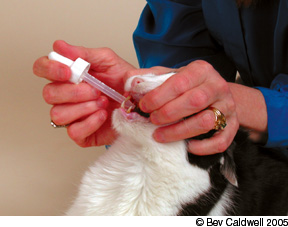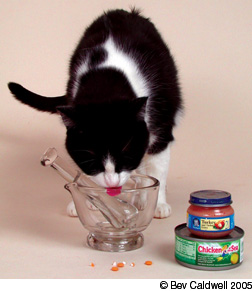Cats are picky patients nonpareil, so dispensing medicine is a challenge even for seasoned owners. Time will reveal what works best for your cat, but these tips may make playing doctor easier whether you are dispensing pills, liquids or something else.

288
Kittens that have been handled extensively are more agreeable as adults to the probing some medications require. Dr. Terry Curtis, DVM, a veterinary behaviorist from the University of Florida, advises owners of young cats to manipulate their pets paws and open up their mouths so they are more amenable to procedures like nail trimming and pilling as adults.
Treat Kitty when she is comfortably resting in her favorite space covered with familiar scents. Some owners report that its best to approach their cat when it is just waking up, explains Dr. Curtis. Wear something to avoid injuries if the situation turns confrontational and talk to kitty as you work. Above all, be confident and quick! Felines are lightning fast, and your pet will react poorly if she detects any owner apprehension.
Recommendations on Restraint
Most cats hate to be restrained. According to Dr. Curtis, The less drama and fanfare the better. Try to use the minimum required to accomplish your mission. Kneel over your pet so your legs surround her and her rump presses against your body. This prevents a rear escape, side-to-side thrashing and encounters with claws.
Wrap more difficult patients in a thick, sturdy towel so that sharp nails cant slip through. Since familiar smells calm cats, rub the fabric on your pet beforehand. Place your feline in the center and bring the two sides over her and tuck the end under her rump, exposing only her head. You can also purchase a cat restraint bag with a neck strap and a zipper. Again, cover the bag with familiar scents to help calm Kitty.
What a Pill!
Kittys least favorite medicine is likely to be a pill, but the techniques described below can make a neophyte feel like a seasoned pro. Dr. Curtis advises coating pills in salmon-flavored cream cheese or butter to help them slide down easier and disguise the bitterness of some medications. You can also try burying pills in a favorite food, but most discriminating cats wont fall for such a simple ploy; theyll just eat around the medication.
Gelatin capsules mask the taste of bitter pills and permit multiple medicines to be combined into one dose. Break Kittys pills into pieces so you can use the smallest gel cap possible. Moistening the capsule with water right before administration will make it slippery and easier for your cat to swallow.
Pillers (also called pill poppers or pill guns) are plastic, tube-shaped devices that place medicines in your cats mouth, eliminating potential finger punctures.
One technique for pilling is to grasp Kitty on the top of her head and tilt it back, pressing your fingers on either side of her mouth. This movement relaxes your pets jaw and opens her mouth slightly. Gently open her mouth further open with the middle finger of your free hand, and quickly push the pill to the middle part of the back of her throat (if using a piller, insert it into her mouth, again as far back as possible, and release the pill). If the pill lands on her tongue, gently push it back with your finger. Immediately close her mouth. Hold her head at an angle with her jaw closed and gently rub her throat or blow lightly into her nose to encourage swallowing.
When administering liquid medications, hold Kittys head level to prevent the liquid from entering her windpipe. Ease the end of the syringe into the space between the cheeks and the gums; either corner of the mouth where the upper and lower lips meet is a good choice. Release the liquid in a slow, steady motion. Your cat will swallow naturally, but afterwards, close her mouth and rub her throat or blow on her nose.
You may be able to combine oral medication with food or liquids – be sure to ask your veterinarian if this is appropriate for the particular medication – but unlike dogs, who wolf down their meals, cats consider each mouthful, so make sure Kitty eats everything.

252
Choose something with a strong flavor that masks the medications taste, like sardine oil. Let Kitty lick it from your fingers or, since cats hate being dirty, smear it on her mouth, nose and paws. Some pharmacies offer transdermal preparations of various medications – where the medication is prepared in a cream and just rubbed inside the ear instead of the cat having to ingest it, explains Dr. Curtis.
Although this method of administration is obviously appealing to many cat owners, not all medications can be given in this way; studies are underway to investigate this promising treatment method.
Warm Liquids First
For ear medications, always warm them to body temperature so that they feel pleasant against Kittys skin. Approach your feline from the side to hide the dropper, and after treatment massage the base of her ear to work the solution into her ear canal. Dr. Curtiss personal technique for more watery medications – like ear rinses – is to saturate a cotton ball with the medication, put the cotton ball into the ear and massage gently around the whole ear canal. That way, the liquid medicine gently flows down into the ear canal. But for fear of causing significant injury, never push a cotton swab or anything else down into the ear unless checking with your veterinarian first.
With eye medication, avoid moving your hand quickly toward Kittys eyes, or else shell become startled. Gently part the upper and lower lids with your thumb and forefinger, and administer the medication, being careful to avoid touching the surface of the eye with the tip of the bottle or tube. After administering ointments, open and close the eyelid one or two times with your thumb and forefinger in order to spread the medication over the entire surface of the eye.
For drops, hold Kittys head so that her nose points upwards, part the eyelids, and aim for the center of her eye. If your cat is uncomfortable receiving drops directly onto her eye, let her close her eyelids , then apply the drops to the inner corner of her eye. While her nose is still pointing upward, gently part the lids and let gravity do the rest.
Keep an eye on your pet to make sure shes keeping the medicine down, especially pills.
Always praise your kitty and give her some play time, catnip and (if your vet says its okay to mix with her medication) her favorite treat. According to Dr. Curtis, Using classical conditioning, just like Pavlov did with his dogs, you can train your pet to associate taking medicine with her favorite yummy treat.



